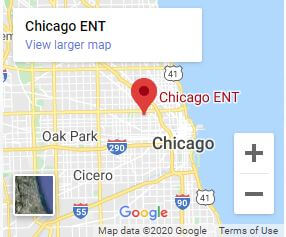Do you suffer from allergies? If you haven’t found relief from traditional treatments, consider sublingual immunotherapy at Chicago ENT.
Sublingual immunotherapy can help reduce your allergy symptoms and build tolerance over time.
What is Sublingual Immunotherapy?
Sublingual immunotherapy (SLIT) is a treatment for allergies, usually in the form of allergy drops or tablets. Treatment involves putting small amounts of liquid, if allergy drops, or small tablets containing allergy extracts. These are placed under the tongue to help desensitize the body and immune system to specific allergens over time.
Using SLIT aims to reduce or eliminate allergic reactions by providing exposure to allergens in small, controlled doses to help the body slowly build up its tolerance.
How Does Sublingual Immunotherapy Work?
SLIT works in a way that’s like allergy shots, but instead of patients receiving shots, the allergen extract gets delivered under the tongue. Delivering the allergen extracts under the tongue allows them to dissolve and be absorbed by the membrane of the mouth, called the oral mucosa.
Then, the allergen enters your bloodstream, where it travels to the immune system. After receiving several months of SLIT, the immune systems of many patients will be able to recognize these allergens as safe rather than something that would cause harm.
SLIT helps develop immunologic tolerance while reducing an overreaction from the immune system when it’s exposed to the allergen later.

What’s the Difference Between Allergy Drops and Allergy Shots?
The most significant difference between allergy drops and allergy shots is how they are administered to patients. Allergy shots (subcutaneous immunotherapy) are injected under the skin.
Allergy drops place extracts of the allergen under the tongue. Extracts between allergy drops and allergy shots can also vary in their composition. However, both provide patients with immunotherapy by gradually increasing the doses of allergen extracts.
Sublingual Allergy Drops versus Sublingual Allergy Tablets
Allergy drops use a customized liquid extract prepared for your specific allergy treatment needs. Allergy tablets use allergen extracts that are then manufactured into convenient and easy-to-dissolve tablets.
Allergy drops and allergy tablets can both treat environmental allergies by using SLIT. Allergy tablets are effective and provide patients with consistent, measurable dosing.
Liquid extracts, as used with allergy drops, allow the ENT specialists at Chicago ENT to fine-tune concentrations and mixtures of allergy extracts for each. Liquid SLIT may also reach immune cells in the mouth’s oral cavity more quickly than allergy tablets.
Who is a Good Candidate for Sublingual Immunotherapy?

SLIT may be appropriate for children and adults suffering from symptoms of hay fever, those with asthma, dealing with recurring sinus infections, or those with hives due to environmental allergies. Your allergist at Chicago ENT will test your allergy sensitivities with skin or blood tests.
If you have severe, unstable asthma or a history of severe systemic reactions to allergy shots, you may not be a candidate for SLIT treatment.
However, it’s proven to be quite helpful when used to relieve and reduce symptoms of dust mite allergies, pollen, pet dander, and mold for many patients with allergies. If you think that you could be a good candidate for SLIT treatment, talk to your allergist at Chicago ENT to learn if it could be suitable for you based on your allergy diagnosis and medical history.
Are there Side Effects with Sublingual Immunotherapy?
SLIT helps minimize risks that are more common with traditional treatments like allergy shots. However, side effects can still happen while undergoing SLIT, especially at the beginning.
These may include experiencing itchy eyes, skin, ears, or mouth, headaches, and digestive distress. Most mild reactions that occur from SLIT are usually resolved with antihistamines if they don’t resolve on their own.
Although rare, SLIT treatment can lead to more severe allergic reactions like difficulty breathing, swelling of the throat, or most severe, anaphylaxis. If you experience these kinds of reactions, make sure to tell your Chicago ENT allergist as soon as possible.
They may change or adjust your dosage, switch the formula being used, or stop SLIT treatment completely if these reactions continue or worsen over time.
Is Sublingual Immunotherapy Covered By Insurance?
Sublingual tablets are FDA-approved and may be covered by insurance. However, sublingual drops are not FDA-approved and not covered by insurance.
The specific extracts used to make sublingual drops are the same FDA-approved extract used in allergy shots, making this off-label. SLIT treatment is not FDA-approved, except for certain allergy tablets. Allergy drops are used for off-label use.
Because of this, insurance coverage for SLIT treatment varies. There may be coverage for tablets but not allergy drops, or another insurance provider may cover allergy drops and not cover tablets.
Before starting SLIT treatment, make sure to verify the benefits of your medical insurance regarding SLIT. This information will ensure you understand potential out-of-pocket expenses and are prepared to pay them if necessary.
How Long Does Sublingual Immunotherapy Take?
For most patients, SLIT treatment lasts between 3-5 years. SLIT takes so long to ensure patients achieve optimal allergy relief.
After establishing the correct dose, you’ll take the maintenance dose year-round for several years. Following this protocol over the recommended time frame is vital as it allows your immune system to fully adapt and build tolerance and immunity to what you’re allergic to.
Most allergists recommend administering your SLIT treatment daily, regardless of its allergy season or not. Doing this ensures the best outcomes in the long term. Once you’ve completed 3-5 years of SLIT treatment at the maximum dosage, your allergist will either have you stop treatment or reduce the frequency of administering as appropriate, depending on your symptom response.
Maintenance SLIT may continue for several years if necessary to manage your allergies or prevent symptoms from worsening over the years.
Do you think you may benefit from SLIT? Learn more by requesting an appointment at one of Chicago ENT’s five convenient locations today!



















